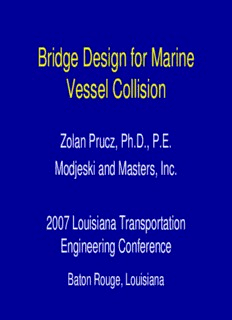
Bridge Design for Marine Vessel Collision PDF
Preview Bridge Design for Marine Vessel Collision
Bridge Design for Marine Vessel Collision Zolan Prucz, Ph.D., P.E. Modjeski and Masters, Inc. 2007 Louisiana Transportation Engineering Conference Baton Rouge, Louisiana • Factors Involved • Historical Developments • Current Design Practice • Recommendations I-40 Bridge, Webbers Falls, OK, May 26, 2002 BRIDGE WATERWAY CHARACTERISTICS CHARACTERISTICS RISK OF VESSEL COLLISION VESSEL TRAFFIC NAVIGATION CHARACTERISTICS CHARACTERISTICS Historical Developments Design Criteria for Vessel Collision Prior to 1980: Criteria was limited to special projects and movable bridge fenders 1980 – 1984: Increase in awareness and research efforts 1984 – 1991: LADOTD Criteria for Vessel Collision Design After 1991: AASHTO Guide Specifications AASHTO LRFD (1994) Vessel Collision Accidents Since 1980 Year Bridge Cause Fatalities 1980 Almo Br., Sweden weather 8 1980 Sunshine Skyway Br., FL weather 35 1982 Lorraine Br., France weather 7 1983 Volga River RR, Russia human error 176 1984 Causeway Br., LA human error 0 1987 Sidney Lanier Br., FL human error 0 1993 Claiborne Ave., LA human error 1 1993 CSX RR Br., AL human error 47 2001 Port Isabel, TX human error 8 2002 Webbers Falls, OK medical cond 12 Causes of Accidents • 70% Human Error (misunderstandings, insufficient information, bad maneuvering, alcohol or drugs, lack of skill, attention or sleep) • 20% Mechanical Failure (engine, steering, navigation instruments) • 10% Extreme Environmental Conditions (winds, currents, fog, rain) Current Design Practice Method I (AASHTO Guide) 1. Collect vessel and waterway data 2. Select design vessel and compute collision loads Method II (AASHTO Guide, AASHTO LRFD) 1. Collect vessel, navigation, waterway and bridge data 2. Perform probability based analysis and select pier capacities AASHTO Method II AF = (N) (PA) (PG) (PC) AF = Annual Frequency of Collapse N = Annual Number of Vessels PA = Probability of Vessel Aberrancy PG = Geometric Probability PC = Probability of Collapse AF acceptable: < 0.0001 for Critical Bridges < 0.001 for Regular Bridges Annual Number of Vessels, N Number of vessels N, grouped by • Type • Size and shape • Loading condition • Direction of traffic Adjusted for the water depth at each pier Probability of Vessel Aberrancy, PA PA = (BR) (R ) (R ) (R ) (R ) B C XC D BR = Aberrancy base rate R = Correction factor for bridge location B R = Correction factor for parallel current C R = Correction factor for cross-currents XC R = Correction factor for vessel density D
Description: